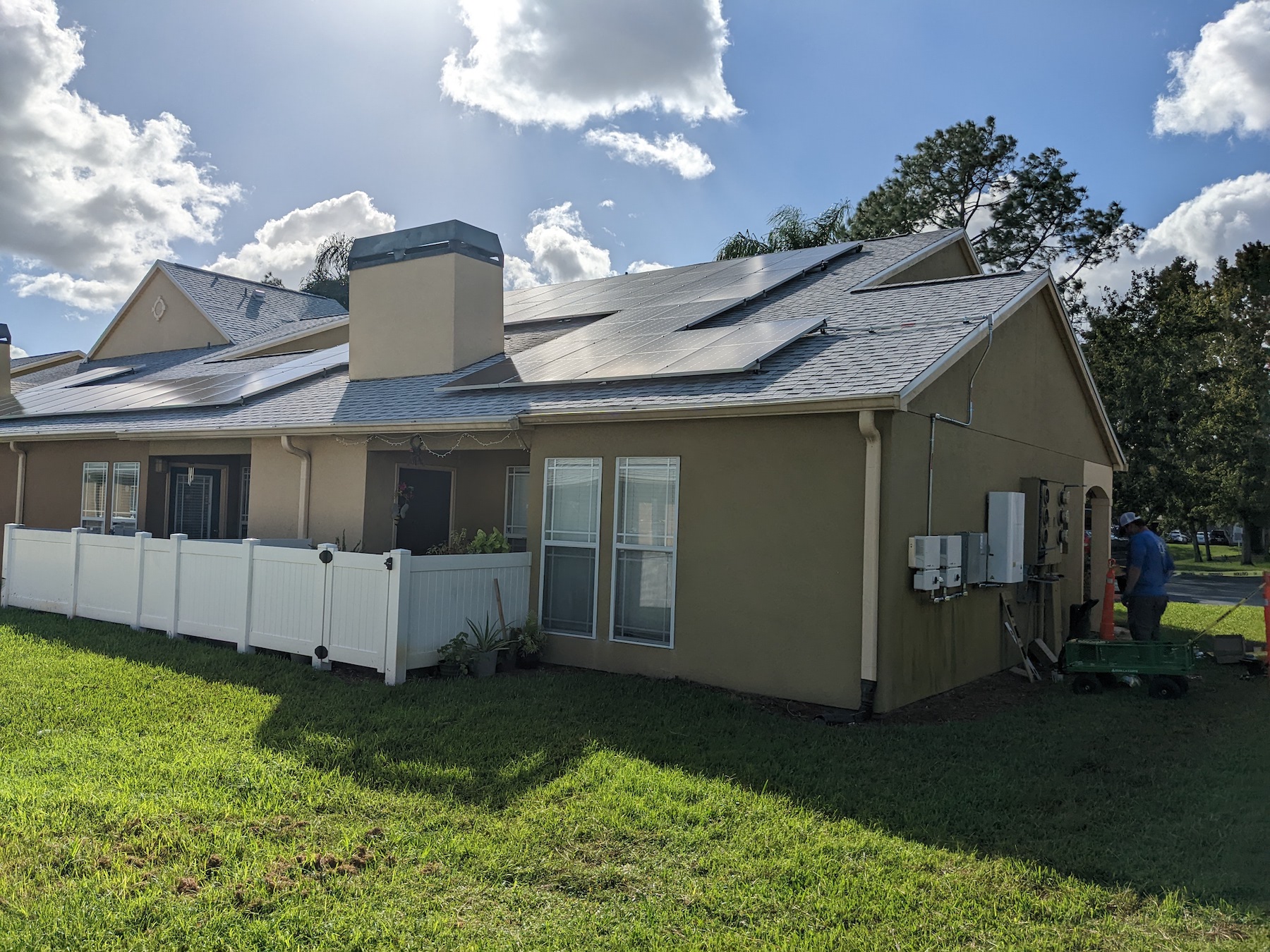Last January, a survey of 10,237 U.S. adults, conducted by Pew Research Center, found that 8% had installed solar panels on their homes, and another 39% had given serious thought to installing solar panels within the previous 12 months.
However, the growth in solar energy alternatives has been mostly confined to commercial buildings and to single-family detached households. Lower-income households, which represent 43% of the U.S. population, are more likely to reside in multifamily buildings that don’t have the mechanical/electrical infrastructure to distribute rooftop-captured solar energy to individual apartments.
Allume Energy is looking to change that. The Australia-based company, with offices in Los Angeles, recently completed its first successful U.S. deployment of SolShare, the company’s shared solar energy technology. Its pilot in the U.S. is a complex in Orlando, Fla., where Allume has connected 65 apartments. Another smaller project in Jackson, Miss., has nine apartment connections. In Jackson, the local utility lowered the application cost because the building caters to lower-income tenants.
Controlling the energy flow

Here’s how SolShare works: Energy from a rooftop solar array flows into the building’s inverter that changes the energy to AC electricity. The inverter sends the electrical current through the SolShare unit to grid meters that are hooked up to apartments. (One SolShare unit can feed up to 10 grid meters.) The electrical distribution moves among the grid boxes several times per second, so when one meter is configured with limits for a particular tenant, the incoming energy gets allocated to the other meters. Any overflow can be sold back to the local energy grid.
Melissa Bergsneider, an executive account manager for Allume Energy, explains that prior to the introduction of the SolShare solution, most landlords were distributing solar energy only to their buildings’ common areas, like a lobby or gym. Those that have been delivering solar energy to apartments were faced with the challenge of how to divide the energy if, for example, a tenant goes on vacation, or an apartment unit is vacant.
SolShare, on the other hand, is “behind the meter,” and its software lets tenants monitor the energy usage. Landlords can still set the rules for how solar energy is allocated throughout the building. One of the advantages of this system, she says, is that it can connect as many apartments as needed. And unlike other so-called “social” solar systems, SolShare provides solar energy at the point of generation rather than exporting it back to the grid.
Allume Energy, which has been in business since 2015, has found that SolShare is reducing tenants’ energy bill, on average, by 30-35%. Bergsneider says that some landlords have been offering Solar as a Service, and are charging tenants a monthly fee for access.
Tax credit boosts demand

Bergsneider declined to disclose SolShare’s cost. She does note, though, that on past projects, SolShare accounted for between 6% and 8% of the total system installation.
Allume Energy’s primary target is low-rise attached rental houses, although it has installed SolShare in mixed-use buildings with commercial tenants. Most of SolShare’s demand is for retrofitting existing buildings, and Allume has been working with solar installation partners; the company has a training program, and a team member is on site for each installation.
Bergsneider attributes demand to the Solar Investment Tax Credit, which offers a 30% credit for individuals installing solar systems on residential properties. This tax credit was extended as part of the August 2022 passage of the Inflation Reduction Act. Bergsneider says there’s a 20% “adder” credit for properties with lower-income residents.
SolShare also helps developers and landlords decarbonize their buildings as part of their Environmental, Social, and Governance goals.
Currently, Allume Energy is focusing its expansion on the Southeast in the U.S. It has also been getting interest for SolShare from building owners in the Northeast and West Coast. Internationally, Allume Energy is targeting Australia, New Zealand, and the United Kingdom.
Related Stories
MFPRO+ News | Jul 22, 2024
6 multifamily WAFX 2024 Prize winners
Over 30 projects tackling global challenges such as climate change, public health, and social inequality have been named winners of the World Architecture Festival’s WAFX Awards.
MFPRO+ News | Jul 15, 2024
More permits for ADUs than single-family homes issued in San Diego
Popularity of granny flats growing in California
Vertical Transportation | Jul 12, 2024
Elevator regulations responsible for some of ballooning multifamily costs
Codes and regulations for elevators in the United States are a key factor in inflating costs of multifamily development, argues a guest columnist in the New York Times.
MFPRO+ New Projects | Jul 2, 2024
Miami residential condo tower provides a deeded office unit for every buyer
A new Miami residential condo office tower sweetens the deal for buyers by providing an individual, deeded and furnished office with each condo unit purchased. One Twenty Brickell Residences, a 34-story, 240-unit tower, also offers more than 60,000 sf of exclusive residential amenities.
Student Housing | Jul 1, 2024
Two-tower luxury senior living community features wellness and biophilic elements
A new, two-building, 27-story senior living community in Tysons, Va., emphasizes wellness and biophilic design elements. The Mather, a luxury community for adults aged 62 and older, is situated on a small site surrounded by high-rises.
MFPRO+ New Projects | Jun 27, 2024
Chicago’s long-vacant Spire site will be home to a two-tower residential development
In downtown Chicago, the site of the planned Chicago Spire, at the confluence of Lake Michigan and the Chicago River, has sat vacant since construction ceased in the wake of the Great Recession. In the next few years, the site will be home to a new two-tower residential development, 400 Lake Shore.
MFPRO+ News | Jun 25, 2024
New York mayor releases multi-year plan to address affordable housing crisis
The plan seeks to create and preserve affordable housing. It will incentivize the inclusion of permanently affordable and rent stabilized housing in new, multi-family construction projects.
Student Housing | Jun 25, 2024
P3 student housing project with 176 units slated for Purdue University Fort Wayne
A public/private partnership will fund a four-story, 213,000 sf apartment complex on Purdue University Fort Wayne’s (PFW’s) North Campus in Fort Wayne, Indiana. The P3 entity was formed exclusively for this property.
Apartments | Jun 25, 2024
10 hardest places to find an apartment in 2024
The challenge of finding an available rental continues to increase for Americans nation-wide. On average, there are eight prospective tenants vying for the same vacant apartment.
MFPRO+ News | Jun 24, 2024
‘Yes in God’s Backyard’ movement could create more affordable housing
The so-called “Yes in God’s Backyard” (YIGBY) movement, where houses of worship convert their properties to housing, could help alleviate the serious housing crisis affecting many communities around the country.

















